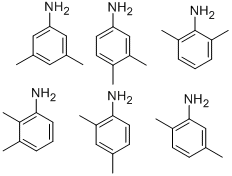
ДИМЕТИЛАНИЛИН
- английское имяDIMETHYLANILINE
- CAS №1300-73-8
- CBNumberCB8478584
- ФормулаC48H66N6
- мольный вес727.08
- EINECS215-091-4
- номер MDLMFCD00167021
- файл Mol1300-73-8.mol
| Температура плавления | -36°C |
| Температура кипения | bp 213-226° |
| плотность | 0,98 g/cm3 |
| показатель преломления | 1.4780 (estimate) |
| Fp | 97°C |
| форма | Liquid, except o-4-xylidine is a solid. |
| Мерк | 14,10084 |
| Диэлектрическая постоянная | 4.4(20℃) |
| Справочник по базе данных CAS | 1300-73-8(CAS DataBase Reference) |
| Рейтинг продуктов питания EWG | 2-5 |
| FDA UNII | 0V872Q19HT |
| Система регистрации веществ EPA | Xylidine (1300-73-8) |
| Заявления о рисках | 23/24/25-33-51/53 | |||||||||
| Заявления о безопасности | 28-36/37-45 | |||||||||
| OEB | B | |||||||||
| OEL | TWA: 2 ppm (10 mg/m3) [skin] | |||||||||
| РИДАДР | 1711 | |||||||||
| RTECS | ZE8575000 | |||||||||
| Класс опасности | 6.1(a) | |||||||||
| Группа упаковки | II | |||||||||
| Банк данных об опасных веществах | 1300-73-8(Hazardous Substances Data) | |||||||||
| Токсичность | LD50 oral in rabbit: 600mg/kg | |||||||||
| ИДЛА | 50 ppm | |||||||||
| NFPA 704: |
|
рисовальное письмо(GHS)
-
рисовальное письмо(GHS)



-
сигнальный язык
опасность
-
вредная бумага
H315:При попадании на кожу вызывает раздражение.
H319:При попадании в глаза вызывает выраженное раздражение.
H351:Предполагается, что данное вещество вызывает раковые заболевания.
H411:Токсично для водных организмов с долгосрочными последствиями.
H330:Смертельно при вдыхании.
H373:Может поражать органы (Нервная система) в результате многократного или продолжительного воздействия при вдыхании.
H301+H311:Токсично при проглатывании или при контакте с кожей.
-
оператор предупредительных мер
P201:Беречь от тепла, горячих поверхностей, искр, открытого огня и других источников воспламенения. Не курить.
P202:Перед использованием ознакомиться с инструкциями по технике безопасности.
P260:Не вдыхать газ/ пары/ пыль/ аэрозоли/ дым/ туман.
P264:После работы тщательно вымыть кожу.
P271:Использовать только на открытом воздухе или в хорошо вентилируемом помещении.
P280:Использовать перчатки/ средства защиты глаз/ лица.
P281:Пользоваться надлежащим индивидуальным защитным снаряжением.
P284:Использовать средства защиты органовдыхания.
P302+P352:ПРИ ПОПАДАНИИ НА КОЖУ: Промыть большим количеством воды.
P304+P340:ПРИ ВДЫХАНИИ: Свежий воздух, покой.
P305+P351+P338:ПРИ ПОПАДАНИИ В ГЛАЗА: Осторожно промыть глаза водой в течение нескольких минут. Снять контактные линзы, если Вы ими пользуетесь и если это легко сделать. Продолжить промывание глаз.
P308+P313:ПРИ подозрении на возможность воздействия обратиться за медицинской помощью.
P310:Немедленно обратиться за медицинской помощью.
P314:В случае плохого самочувствия обратиться к врачу.
P332+P313:При возникновении раздражения кожи: обратиться за медицинской помощью.
P403+P233:Хранить в хорошо вентилируемом месте в плотно закрытой/герметичной таре.
P405:Хранить в недоступном для посторонних месте.
P501:Удалить содержимое/ контейнер на утвержденных станциях утилизации отходов.
ДИМЕТИЛАНИЛИН химические свойства, назначение, производство
Химические свойства
Liquid. Slightly soluble inwater; soluble in alcohol and ether. Combustible.Использование
Chiefly in the manufacture of dyes.Определение
A varying mixture of isomers (2,3-; 2,4-; 2,5-; 2,6-).Опасность
Toxic by ingestion, inhalation, and skin absorption. Liver damage. Methemoglobinemia. Possible carcinogen.Угроза здоровью
Xylidine causes liver damage in experimental animals and is a mild methemoglobin former; it caused tumors of the nasal cavity in rats. There are six isomeric forms of xylidenes with the commercial product consisting primarily of the 2,4- and 2,6-isomers.Профиль безопасности
Confirmed carcinogen. Poison by intravenous route. Moderately toxic by ingestion. This material, which so closely resembles aniline in the character of its toxic effects, is actually twice as toxic as aniline. It can cause injury to the blood and the liver. It does not necessarily give any alarm or warning, such as cyanosis, headache, and duziness, whch characterize aniline poisoning. Thus, it may be considered a more insidious poison than aniline, and severe and possibly fatal intoxication may come about through skin absorption. Combustible when exposed to heat or flame. Can react vigorously with oxidizing materials. To fight fire, use foam, CO2, dry chemical. When heated to decomposition it emits toxic fumes of NOx. See also ANILINE and other xylidme entries.Возможный контакт
Xylidines are used in dyestuff manufacture; as intermediates in the manufacture of pesticides, antioxidants, pharmaceuticals, and other organic com pounds.Канцерогенность
The IARC has determined that there is sufficient evidence for the carcinogenicity of 2,6-xylidine in experimental animals and inadequate evidence in humans.5 Overall, 2,6- xylidine is considered possibly carcinogenic to humans. In genotoxic assays, 2,6-xylidine induced sister chromatid exchanges and chromosomal aberrations in cultured mammalian cells but did not induce micronuclei in the bone marrow of mice treated in vivo; conflicting results have been reported in the Salmonella typhimurium assay.Перевозки
UN1711/Xylidines, solid or liquid, Hazard Class: 6.1; Labels: 6.1-Poisonous materials.Несовместимости
Vapor may form explosive mixture with air. Contact with hypo chlorite salts and bleaches form explosive chloroamines. Incompatible with oxidizers (chlorates, nitrates, peroxides, permanganates, perchlorates, chlorine, bromine, fluorine, etc.); contact may cause fires or explosions. Keep away from alkaline materials, strong bases, strong acids, oxoacids, and epoxides. A chemical base: Will neutralize acids to form salts plus water with an exothermic reaction. May be incompatible with isocyanates, halogenated organics, peroxides, phenols (acidic), epoxides, anhydrides, and acid halides. Flammable gaseous hydrogen is generated by amines in combination with strong reducing agents such as hydrides, nitrides, alkali metals, and sulfides.Утилизация отходов
Incineration; oxides of nitrogen are removed from the effluent gas by scrubber, catalytic, or thermal device.ДИМЕТИЛАНИЛИН запасные части и сырье
сырьё
запасной предмет
ДИМЕТИЛАНИЛИН поставщик
| поставщик | телефон | страна | номенклатура продукции | благоприятные условия |
|---|---|---|---|---|
| +86-86-5926051114 +8618959220845 |
China | 6383 | 58 | |
| 86-13657291602 | CHINA | 22963 | 58 | |
| +86-0371-86658258 +8613203830695 |
China | 29809 | 58 | |
| +86 13288715578 +8613288715578 |
China | 12825 | 58 | |
| +86-0551-65418671 +8618949823763 |
China | 34563 | 58 | |
| +8615255079626 | China | 23541 | 58 | |
| +86-592-5360779 +86-13055435203 |
China | 5988 | 58 | |
| +8617732866630 | China | 18147 | 58 | |
| +86-852-30606658 | China | 43340 | 58 | |
| +86-18621343501; +undefined18621343501 |
China | 33338 | 58 |